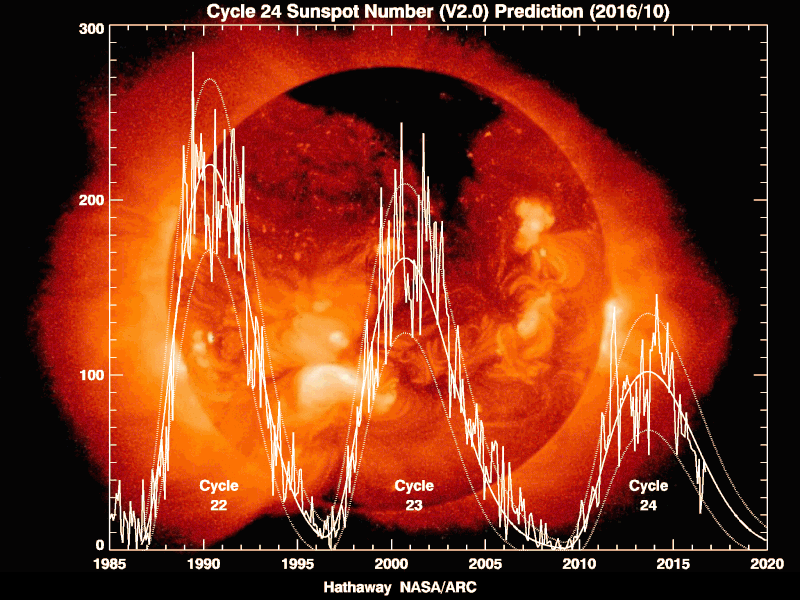Note4Students
From UPSC perspective, the following things are important :
Prelims level: Solar Cycle, Sunspots, Solar Dynamo
Mains level: Read the attached story

The sunspots identified by researchers from IISER Kolkata herald the start of a new solar cycle called Cycle 25.
What are Sunspots?
- Sunspots are temporary phenomena on the Sun’s photosphere that appear as spots darker than the surrounding areas. They are relatively cooler spots on the Sun’s surface.
- They are regions of reduced surface temperature caused by concentrations of magnetic field flux that inhibit convection.
- Sunspots usually appear in pairs of opposite magnetic polarity with a leader and a follower.
What is Solar Cycle?

- From our safe distance of about 148 million km, the Sun appears to be sedate and constant. However, huge solar flares and coronal mass ejections spew material from its surface into outer space.
- They originate from sunspots, an important phenomenon that people have been following for hundreds of years. They originate deep within the Sun and become visible when they pop out.
- Their number is not constant but shows a minimum and then rises up to a maximum and then falls again in what is called the solar cycle.
- Every 11 years or so, the Sun’s magnetic field completely flips. This means that the Sun’s north and south poles switch places. Then it takes about another 11 years for the Sun’s north and south poles to flip back again.
- So far, astronomers have documented 24 such cycles, the last one ended in 2019.
How do they occur?
- Given the high temperatures in the Sun, matter exists there in the form of plasma, where the electrons are stripped away from the nuclei.
- The Sun is made of hot ionized plasma whose motions generate magnetic fields in the solar interior by harnessing the energy of the plasma flows.
- This mechanism is known as the solar dynamo mechanism (or magnetohydrodynamic dynamo mechanism).
- Simply stated, it is a process by which kinetic energy of plasma motions is converted to magnetic energy, which generates the magnetised sunspots, giving rise to the solar cycle..
- Because of the nature of the solar dynamo, the part of its magnetic field that gives rise to sunspots reverses direction when it moves from one solar cycle to another.
- This can be inferred by observing when the relative orientation of the sunspot pairs flips.
Features
- The solar cycle affects activity on the surface of the Sun, such as sunspots which are caused by the Sun’s magnetic fields. As the magnetic fields change, so does the amount of activity on the Sun’s surface.
- One way to track the solar cycle is by counting the number of sunspots.
- The beginning of a solar cycle is a solar minimum, or when the Sun has the least sunspots. Over time, solar activity—and the number of sunspots—increases.
- The middle of the solar cycle is the solar maximum, or when the Sun has the most sunspots. As the cycle ends, it fades back to the solar minimum and then a new cycle begins.
- Giant eruptions on the Sun, such as solar flares and coronal mass ejections, also increase during the solar cycle. These eruptions send powerful bursts of energy and material into space.
Impacts of Solar Cycle
- This activity has effects on Earth. For example, eruptions can cause lights in the sky, called aurora, or impact radio communications. Extreme eruptions can even affect electricity grids on Earth.
- Solar activity can affect satellite electronics and limit their lifetime.
- Radiation can be dangerous for astronauts who do work on the outside of the International Space Station.
- Forecasting of the solar cycle can help scientists protect our radio communications on Earth, and help keep satellites and astronauts safe.
Start of cycle 25
- Following a weakening trend in activity over the last few cycles, there were predictions that the Sun would go silent into a grand minimum in activity, with the disappearance of cycles.
- However, a team from IISER Kolkata has shown that there are signs that cycle 25 has just begun.
- They used the data from the instrument Helioseismic and Magnetic Imager aboard NASA’s space-based Solar Dynamics Observatory for their calculations.
Why is this so important to us on earth?
- After all the sunspots look small and are hardly even visible to us. Contrary to this, sunspot activity may be correlated with climate on earth.
- In the period between 1645 and 1715, sun spot activity had come to a halt on the Sun – a phenomenon referred to as the Maunder minimum.
- This coincided with extremely cold weather globally. So sunspots may have a relevance to climate on earth.
- Such links are tenuous, but definitely solar activity affects space weather, which can have an impact on space-based satellites, GPS, power grids and so on.
Get an IAS/IPS ranker as your 1: 1 personal mentor for UPSC 2024

So can we say that sun spots might be some indirect cause for wild fires across allover the world last year?
CME was lowest at its’ cycle last year, why would it be reason for wildfires ?